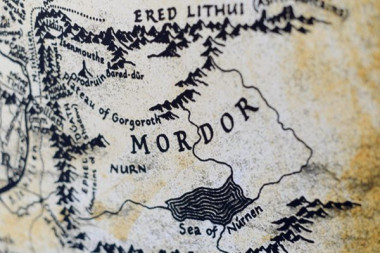Is Mordor Based on the Himalayas?
extract
Where on earth was Middle-earth? Based on a few hints by Tolkien himself, we’ve always sort-of assumed that his stories of “The Hobbit” and “The Lord of the Rings” were centered on Europe, but so long ago that the shape of the coasts and the land has changed.
But perhaps that’s too easy and too Eurocentric an assumption; perhaps, like so many other things these days, Tolkien’s fantasy realm too is in dire need of mental decolonisation.
And here’s an excellent occasion: an Iranian Tolkienologist has found intriguing hints that the writer based some of Middle-earth’s topography on mountains, rivers, and islands located in and near present-day Pakistan.
… (read all on the site)
In an article published on Arda.ir, the web page for the Persian Tolkien Society, Mohammad Reza Kamali writes that during several years of cartographic study, “I found that maybe there are real lands [that] could have inspired Professor Tolkien, and some of them are not in Europe.”
Around 2012, Kamali’s eye stopped when it came across a Google Map of Central Asia that showed the mountain chain of the Himalayas, the peaks of the Pamirs bunched together in an almost circular area, and the huge, flat oval of the Takla Makan desert, bounded to the north by the Tian-Shan mountains.
…
But are these similarities really more than coincidences? Why would Tolkien, who was based in Oxford and steeped in English lore and Germanic mythology, turn to the Indian subcontinent for topographical inspiration? Perhaps because cartographic knowledge of that part of the world was far more general in Britain then than it is now. Until the late 1940s, the countries we know today as India and Pakistan were part of the British Empire. Detailed maps of the region would have been standard fare for British atlases.
Kamali is convinced that the topographical features on Tolkien’s map of Middle-earth are not mere fantasy, but derive from actual places in our world, and were ‘riddled’ onto the map. In that case, we may look forward to more discoveries of Tolkien’s real-world inspiration.
Here’s one example of Tolkienography—if that’s what we can call the effect of actual geography on this particular writer’s imagination—which I gleaned myself, some years ago in East Yorkshire. A local historian told me that Tolkien had been stationed in the area during the First World War, and had apparently stored away some local place names for later use. The name Frodo, he said, derived from a town where he had attended a few dances – Frodingham, a village across the Humber in northern Lincolnshire, not far from Scunthorpe (Scunto? We dodged a bullet there).
Whether that story is entirely true or not is beside the point. As fantasy fans know, any grail quest is ultimately about the quest, not the grail. In fact, to quote Mr Kamali, the treasure is important only because it’s well hidden, “by a clever professor who enjoys riddles.”

Add comment